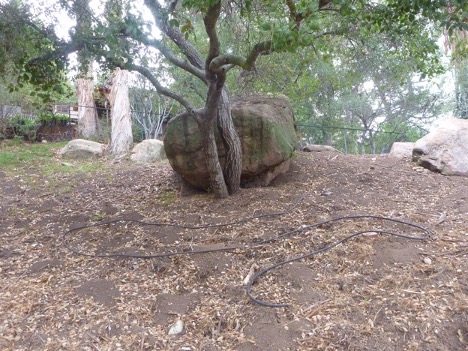By Rosi Dagit, Certified Arborist, Sr. Conservation Biologist

While our long lived trees are able to withstand quite a bit, the combination of almost 20 years of below normal precipitation and more days with extreme heat, they are being pushed to their limit.
If your trees have not usually had irrigation, then the best strategy is to do a long slow deep soak overnight once a month using a soaker hose set at least 3 ft. away from the trunk and extending out to the edge of the canopy if possible. The goal is to get the soil under the hose wet down about 4-6 inches.
Adding a 2-4 inch layer of tree leaf mulch to protect the soil and roots from the direct impact of the sun will also help. Even better, instead of raking up or removing the leaves that fall, sweep them into a manageable layer under the dripline of the tree. This allows the leaves to disintegrate and recycle nutrients back into the tree while providing many other benefits. The tension between maintaining a good level of mulch without setting up a potential fire hazard means that you should take care of surrounding areas and not allow build up within 5 feet of any structures. There is a lot of really helpful information about how to manage your landscape for fire safety at https://defensiblespace.org/
If your trees have been getting irrigated as part of your yard, then taper them down rather than stop watering abruptly. After about a month they should be able to handle the once a month regime.
For Oaks in particular it is really critical to not have the water directly hit the trunk or the area within about a 3 ft. radius of the trunk. Root rots love warm wet soils and so the trick is to provide sufficient water to support the tree, without too much to give the root pathogens time to proliferate. Letting the soil dry out between the monthly deep soaks is the best strategy. For a deeper dive into how to care for oaks during drought check out the UCA NR Green Blog post at https://ucanr.edu/blogs/blogcore/postdetail.cfm?postnum=17495
Another important consideration is not to prune trees during the hot summer months when water stress is high. In addition to protecting any nesting birds, the leaves are what generate energy for the tree, provide shade to moderate the soil temperature under the canopy, and provide much loved shade for all of us, so removing them causes additional stress.
You can help nurture the baby oaks planted at Trippet Ranch in Topanga State Park by “adopting” one of the trees you see along the trail. The RCDSMM Stream Team has been growing over 250 oaks to reforest an area where mature trees were killed in 2015 due to drought and impacts from beetles. We rely on volunteers to help water the trees every two weeks. Sign up to help at https://www.rcdsmm.org/upcoming-events/. In addition, if you carry an extra liter or two of water as you hike up to Eagle Rock or Parker Mesa, you can share that water with one of the baby trees and supplement what they are getting from us. Our data shows that the trees that received extra water from their adopted caregivers are growing faster than those that are just getting the minimum we can provide!
All our trees deserve our care as the stresses faced not only by them, but by us mount up. And the added benefit of taking care of our trees, is that they then take care of us and many other creatures that rely upon them for food, nest sites, or shelter. Spending even 20 minutes a week enjoying the company of a tree has been shown to provide numerous health benefits! Hope to see you among the trees!

Photo courtesy of RCDSMM Stream Team




